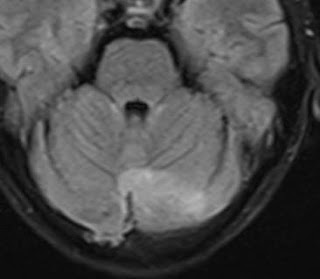T1 and STIR images in coronal plane; T2 GRE, T1 and T2 FS images in axial plane in a 25 year old female reveal a well-defined soft tissue mass along the ulnar aspect of flexor pollicis longus tendon abutting the proximal phalanx of left thumb. It shows hypointense signal on gradient echo image suggestive of paramagnetic substance.
GIANT CELL TUMOUR OF TENDON SHEATH:
This is the second commonest tumour of hand after simple ganglion cyst.
Types: It is of two types, the common localized type and the rare diffuse variety. The diffuse variety is considered the soft tissue counterpart of diffuse PVNS and is more common in lower extermities.
Age: 30-50 years, peak at 40-50 years.
Sex:Female to male ratio is 3:2
Presentation: Commonly occurs along the volar aspect of hand/ finger and is common adjacent to a DIP joint. It presents as a firm, lobulated, non-tender and slow growing mass which is fixed to underlying structures.
Imaging:
X-ray may show cortical erosion, calcification etc.
USG shows a soft tissue mass along a tendon sheath with vascularity on color/ power doppler.
MRI shows low to intermediate signal on T1 and T2 spin echo sequences due to the presence of hemosiderin. This effect is further exaggerated and blooms on gradient echo sequences.
References:
-Wan JM, Magarelli N, Peli WC, Guglielni G, Sheli TW. Imaging of Giant cell tumour of the tendon sheath. Radiol Med.2010 Feb; 115(1): 141-51
-Verheyden JR. Giant cell tumour of the tendon sheath. emedicine.medscape.com
GIANT CELL TUMOUR OF TENDON SHEATH:
This is the second commonest tumour of hand after simple ganglion cyst.
Types: It is of two types, the common localized type and the rare diffuse variety. The diffuse variety is considered the soft tissue counterpart of diffuse PVNS and is more common in lower extermities.
Age: 30-50 years, peak at 40-50 years.
Sex:Female to male ratio is 3:2
Presentation: Commonly occurs along the volar aspect of hand/ finger and is common adjacent to a DIP joint. It presents as a firm, lobulated, non-tender and slow growing mass which is fixed to underlying structures.
Imaging:
X-ray may show cortical erosion, calcification etc.
USG shows a soft tissue mass along a tendon sheath with vascularity on color/ power doppler.
MRI shows low to intermediate signal on T1 and T2 spin echo sequences due to the presence of hemosiderin. This effect is further exaggerated and blooms on gradient echo sequences.
References:
-Wan JM, Magarelli N, Peli WC, Guglielni G, Sheli TW. Imaging of Giant cell tumour of the tendon sheath. Radiol Med.2010 Feb; 115(1): 141-51
-Verheyden JR. Giant cell tumour of the tendon sheath. emedicine.medscape.com











